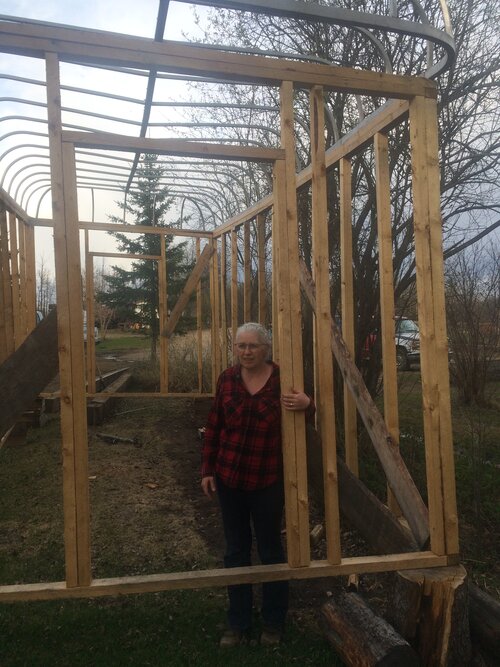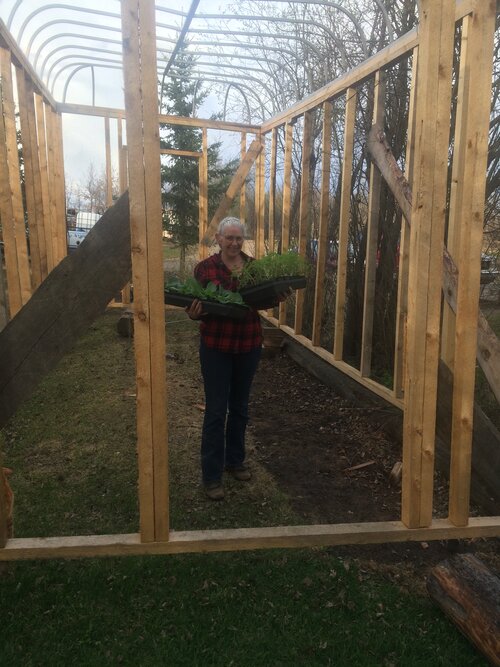HOW WE SHORTEN THE FOOD SUPPLY CHAIN
posted on
May 8, 2020
Spring has finally arrived in northern Alberta making our days very busy. The last of the snow piles disappeared this week, and a day of showers brought any remaining frost out of the ground.
I don’t know if I would consider our family preppers in the apocalyptic sense of the word. But, it has always been really important to my family to keep our food supply chain really short. I am pretty sure that my grandparents and mother instilled this mentality in me.
My grandparents both lived through two world wars, experiencing first hand the scarcity that these upheavals create. They always raised and preserved most of their food.
Twenty seven trays of seedlings outside the kitchen door. We move these trays in and out of the house morning and evening.
My mother, as a single working mother raising three children always had a large garden too. When the stresses of life came, she always knew that she had enough food to keep her family well nourished even if we had to live without in other areas.
So, when Larry and I were married it was naturally important for me to raise our own food. Now, let me tell you though; just because a person grows up in a gardening family doesn’t mean that it is easy to have the success they had. It took a few years to figure it out on my own. I am thankful that we have access to such wonderful organic gardening literature and that my mother and grandmother were always there so I could ask questions.
Most of the animals have been moved to pasture, but still require hay to supplement the carryover grass until the new grass is ready for them. The calves and lambs have started to arrive. The meat chicks are already four weeks old. Next week they will be moved out to pasture. The laying hens are on their way to the new garden area to help us prep it for planting. They will lightly till the ground while searching for seeds and bugs.
My new greenhouse! It is just a little drafty at this point.
Beside the everyday chores of tending to the needs of the animals, gardening season is upon us. Technically it actually started indoors way back in March. We only have a ninety day frost-free growing season. This means that we have to start many of our seeds indoors.
I find it a blessing to be able to start the plants indoors because in March we are still in the dead of winter. When the tiny plants peek out of their trays it reminds me that winter will not last forever. It doesn’t take these tiny little plants long to take over your house. We have just about thirty trays of plants waiting to be planted outside. They consist of cabbages, cauliflower, broccoli, tomatoes, peppers, tomatillos, herbs and flowers. The brassicas will be going into the garden next week with a floating row cover over them. All the rest have to wait until June 1st to be planted out. We have been carrying all these tray outside in the morning and bringing them all back in the house in the evening. This activity gets old really fast, but our weather is just too unpredictable at this time of year.
We are going to fill this little greenhouse to capacity.
So, this is the year that I am getting my little greenhouse to put all these tender babies into so we don’t have to move them in and out of the house (I might even be able to see my kitchen floor again). It is a simple structure made from salvaged material and lumber from a local mill. This coming week we will be moving it to its permanent location and putting the plastic on it.
Come June when all the plants can be put in the garden, I will not be abandoning the greenhouse for the season. We will be building permanent in-ground beds that will house some of the tomatoes, peppers and cucumbers for the summer. I have never grown in a greenhouse, so I am hoping for success.
I am looking forward to experimenting with a few different methods of growing the garden this year. We will be using more plastic mulches for the transplants. Last year saw an explosion of Canada Thistle, so we are hoping that the mulch will help control this annoying weed. We will once again be using natural mulches as well. We have been using compost that we carefully make as a mulch. We have tried straw, but have found that it keeps the soil too cool and hinders the growth of the plants. The compost is dark and rich so we get the benefits of its fertility and the dark colour that helps warm up the soil.
Does life get busy for you in the spring? What activities are on your to-do list?






